I spent $200 on a backpack for my quadcopters. Well, more accurately, my wife spent $200 on a backpack for my quadcopters. Is it a dumb idea? What was wrong with the old $13 tactical backpack? Wouldn’t it be way more fun to spend that $200 on another racing quad?
I just asked a lot of questions. I asked myself all these questions and more when I was shopping for a backpack upgrade, and I bet you’re asking these questions, too.
Most people shouldn’t spend $200 on a backpack
It was not a dumb idea. It has been one of the biggest upgrades to my flying experience—I’ll go into more detail shortly. There was nothing wrong with my $13 30-liter tactical backpack.
If you’re just starting out, don’t buy a $200 bag. Aside from some trouble with one of the zippers, my inexpensive tactical backpack from eBay is still working well. I passed it on to my nephew when we gave him a BFight 210 for Christmas. I’m sure he’ll get tons of use out of it.
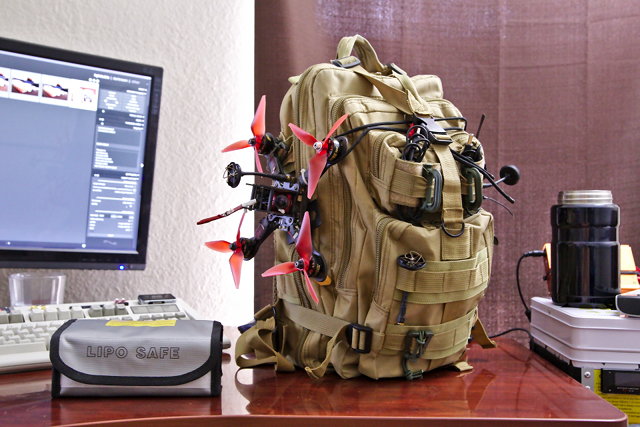
I used that backpack for eight or nine months, and it served me well. I could cram a lot of stuff in and on the bag: a dozen batteries, an assortment of tools, lots of spare props, a couple of micro quads, and two or three 5” racing quads.
If you don’t currently have a solution for carrying your drones, you can’t go wrong with everyone’s favorite tactical backpack. It is extremely versatile, but I wouldn’t buy it again. The AmazonBasics DSLR backpack is better suited to carrying FPV quads and gear.
If you already have a backpack, and you’re happy with it, I think you should stick with your current solution. The best bag might be the one you already have. Spend your $200 on a Furibee Fire Dancer or BFight 210 instead!
- ThinkTank FPV Airport Helipak at Amazon
- AmazonBasics DSLR Backpack at Amazon
What I was looking for in a quadcopter backpack
All the FPV content is on YouTube, so I end up watching lots of videos. When you watch these videos, you’ll see folks using these giant backpacks. When they open them up, all their gear is right there. All ready to be used.
With my tactical backpack, I had to unpack quite a few things before I could start flying. That unpacking takes about three minutes, and I end up having to spread my stuff out. I had to unstrap two quads, pull out my battery back, then pull out my Taranis case.
That sounds easy enough, but then I still have to unpack my Taranis and goggles from their case before I can even start powering things up.
Packing everything back up takes more time than unpacking.

I wanted a backpack that I could set down on the ground next to my chair. Then I could just unzip it, open the flap, sit down, and start pulling things out as I need them. Everything should have a home in the bag, and I should be able to drop stuff back in its slot when I’m not using it.
There are three popular bags that seemed like they could meet my needs: the Lowepro QuadGuard BP X3, the BetaFlight Hive, or the ThinkTank FPV Airport Helipak. You already know which one I picked, so lets talk about why I eliminated the other two options.
- ThinkTank FPV Airport Helipak at Amazon
- AmazonBasics DSLR Backpack at Amazon
Why not the Lowepro QuadGuard BP X3 or Betaflight Hive?
I had one major problem with both these bags. They expect you to strap your quads to the back of the bag. I think this is problematic, because when you open the backpack, the back becomes the bottom.
That means you might have to unstrap all your quads before you even get started. I really wanted to avoid that.
I like the Betaflight Hive’s dedicated compartment for your transmitter, but you’re out of luck if you use a Spektrum radio.
The Betaflight Hive has a really cool tool holder that pops out of the bag. This looks like a nice touch. Unfortunately, they used several rows of elastic straps, and everyone seems to think it is a pain to get your tools back into the straps.
I don’t like the Lowepro BP X3’s solution to transmitter storage. It is well thought out, but you end up storing your quadcopters on top of your transmitter. That means you have to take your quads out of the bag to get to the transmitter.
This made me realize what my goal actually is. I want to avoid having my gear in a last-in, first-out situation.
With my old tactical backpack, I had to unstrap my quads to get to my batteries, and I had to unload my batteries to get to my transmitter.
- ThinkTank FPV Airport Helipak at Amazon
- Lowepro QuadGuard BP X3 at Amazon
- AmazonBasics DSLR Backpack at Amazon
The ThinkTank FPV Airport Helipak
The ThinkTank bag is as big as its name. It is ginourmous. It is so big that you can easily fit three 5” quads inside in the bag’s default configuration. In fact, I was able to fit every single thing that was inside or strapped on my tactical backpack inside the Airport Helipak and I still had room to spare!

As its name implies, the ThinkTank Airport FPV Helipak just barely fits under the size limit for carry-on bags. I must admit that I only checked the airlines that I’m likely to use. It will be allowed on United or American Airlines flights, and Southwest allows even bigger carry-on bags. I assume this is the reason the word Airport is included in this bag’s long name.
This bag works differently than the Lowepro X3 or Betaflight Hive. The Helipak opens like a normal backpack. There’s plenty of room to strap two or three quads to the back of the Helipak. You’ll have to come up with your own solution for attaching them—I use loops of bungie cord.
I thought it would be a bad idea to strap quads to the back, since they’d get in the way when you want to open the bag. I have gone out to the field with one quad strapped to the back, and it isn’t a problem. You can open the bag with the quad still attached. It would be difficult to run out of room for quads in this bag!
- ThinkTank FPV Airport Helipak at Amazon
- Lowepro QuadGuard BP X3 at Amazon
- AmazonBasics DSLR Backpack at Amazon
What fits inside?
An exhaustive list of every item in my bag would be long and uninteresting. Here’s the important stuff that I’m currently carrying.
- Fat Shark Dominator V3 goggles with antennas attached
- Spare batteries for the goggles
- Two 5” racing quads with props
- A 6” racing quad with props
- Two micro racing quads
- A dozen 4S LiPo batteries
- Assorted micro quad batteries
- Wowstick screwdriver
- Piranha multitool
- 8mm prop nut driver
- Motor pliers
- An XT60 soldering iron
- Tons of props
- An action camera
- An assortment of other tools
The ThinkTank bag has a tripod strap on each side. It seems to be the same design that they use on their camera bags. I have a tripod with a FauxPro action cam on one side, and I have my 4” racing drone on the other. The 4” drone would fit in the stack of quads on the inside, but I rarely fly it, so I didn’t want it to be in the way.
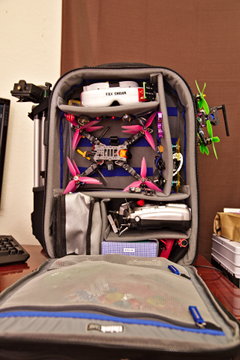
As you can see from the photo, almost all of this gear is easily accessible. You never have to pull one item out to get to another. The Taranis X9D Plus fits on its side. One of the compartments will fit four rows of 3 batteries, and it is tall enough to make that stack two batteries tall. I’m excited that I can fit 24 batteries in here without reconfiguring anything!
Everything is quickly accessible except for the quads. The drones are stacked on top of each other, so if you want to fly the quad on the bottom, you need to take all the others out. If I have a complaint about this bag, this is it. Thankfully, it is a very minor complaint and it rarely impacts my flying.
I make sure my quads are stacked in the correct order. The one I want to fly is on top, and my worst backup quad goes on the bottom. This seems to be a reasonable arrangement.
The only thing that goofs this up is the 6” quad. With my configuration, the props don’t actually fit in the slot I have for my drones. The frame fits, though, and the Hyperlite Floss 2 frame isn’t much taller than the props. I just stick the 6” on top with the props sticking out past the dividers. This works well, but I always have to pull this drone out of the bag.
- ThinkTank FPV Airport Helipak at Amazon
- AmazonBasics DSLR Backpack at Amazon
What’s in the lid?
There is another zippered compartment on the lid. It has room for a 15.6” laptop, and there are a few small compartments in there.
I rarely bring a laptop out to the field, but I could see this being quite useful when traveling. I don’t like to keep important things in this compartment, because it is more difficult to access once the bag is already open. I tend to drop things on the inside of the lid when I’m flying to make sure I don’t lose them.
I made sure to put important tools that I use every day inside the main compartment. I put the tools that I only use once in a while, like my XT60 soldering iron, in the laptop compartment. So far, I’ve reattached and ESC wire on only two occasions.
What if I don’t want to put my quads inside the bag?!
I’m happy to carry my quads inside the bag. It keeps them out of the way, and they don’t get snagged on anything when you’re unloading your bag from the car. If that’s not your thing, or you just need to fit even more stuff inside your bag, the ThinkThank Helipak has you covered.
Each side of the bag has a pouch on the bottom and a strap on the top. These are made for carrying tripods—it is obvious that ThinkTank is a camera bag company! I have no trouble using these straps to carry extra 5” or 6” quads. In fact, I carry a 4” quad using one of these straps.
There’s also a series of loops running down each side of the back of the bag. I needed to carry an extra BFight 210 to the field one day, and I was out of room everywhere else. I tied some short lengths of ¼” Bungie cord loops to the top pair of fittings, and I was able to hook one motor into each loop.

In a pinch, I think I would be willing to pack three quads on the back and one on either side of the bag.
I was worried about carrying drones on the back of the bag. In my opinion, the biggest drawback to the Lowepro QuadGuard and Betaflight Hive is how the back of the bag becomes the bottom of the bag when you have to open the lid. That means you have to remove all your quads from the back before opening it.
Wouldn’t you have the same problem with the ThinkTank Helipak? Even though the back is the lid, won’t you still have to remove all the quads to comfortably open the bag?
To my surprise, I didn’t have to. I just flopped the bag open, and the BFight 210 was resting comfortably on the ground. I didn’t have to worry about it, because the whole weight of the backpack wasn’t resting on the quad.
- ThinkTank FPV Airport Helipak at Amazon
- Lowepro QuadGuard BP X3 at Amazon
- AmazonBasics DSLR Backpack at Amazon
Some nice touches
ThinkTank did a great job designing a backpack with the FPV quad pilot in mind. The internal compartments are quite configurable. I took two dividers out, but I left everything set up very much like it came from the factory.
I moved some of the dividers to make some of the compartments have a snug fit, and I made the compartment for the quadcopters a little bigger. My pair of stretch-x OwlRC Dragon frames were a little long for the stock configuration. The props rub a bit on the way in, but it doesn’t take much wiggling to get them in place.
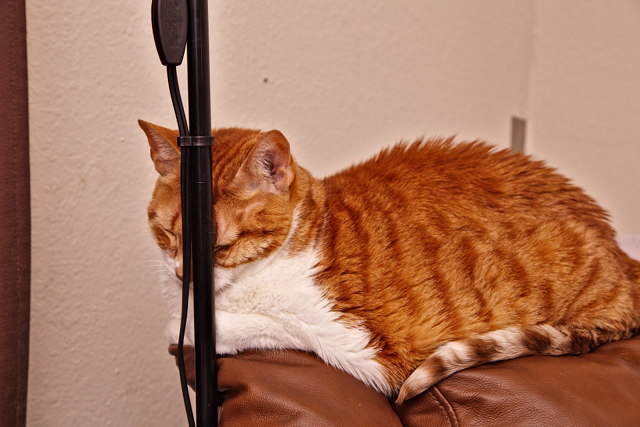
The entire top half of the bag has elastic tool holders all around the sides and the floor, and all of the larger removable panels have the same elastic tool holders as well. I have all sorts of wrenches, drivers, and antennas stuck in those holders. ThinkTank has done a fantastic job at making sure I’m not wasting any space.
- ThinkTank FPV Airport Helipak at Amazon
- AmazonBasics DSLR Backpack at Amazon
Velcro is your friend
The rough, hook side of Velcro sticks to the inside of camera bags. This should be obvious, because all of these big FPV backpacks are just overgrown camera bags, and all their dividers connect using Velcro.
If you want to stick something to the side, all you need is some stick-back Velcro tape. So far, I only have a couple of battery checkers stuck to the wall of my battery compartment. I’m sure there are other neat things I could be sticking to the walls.
Cheaper alternatives
I’ve been quite happy with my $13 tactical backpack from eBay. I kept my Fat Sharks and Taranis X9D in a Turnigy transmitter case, and that Turnigy case just barely squeezed into the big compartment of the backpack. There is plenty of room left over at the top of the compartment for a big battery bag. There are tons of places to strap drones to the outside, and plenty of pockets left over for props and micro drones.

Now that I’ve experienced the ThinkTank FPV Helipak, I wanted to find a better budget bag. Something that provides many of the same features, but at a fraction of the price. I think I’ve found that bag.
My favorite alternative is the AmazonBasics DSLR backpack. It is priced at $27 with 2-day Prime shipping. That’s about what I paid for my cheaply made tactical backpack and Turnigy radio case, but it does the job of both!
The AmazonBasics backpack probably achieves 80 percent of my goals at around 15 percent of the price of the ThinkTank FPV Airport Helipak. The AmazonBasics bag is much smaller than the $200 bags, so I wouldn’t be able to carry nearly as much gear, but it is a very capable bag for the price.
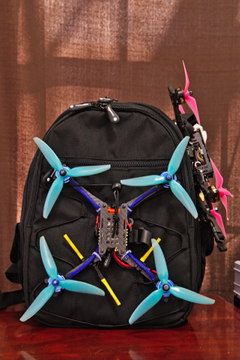
You won’t be able to fit any quads inside the AmazonBasics backpack, but that’s true of most of the purpose-built FPV backpacks as well. Strapping two 5” quads to this backpack was easy. I tied one into the elastic webbing on the back and a second into one of the tripod straps on the side. You could probably squeeze one more quad into the webbing and another into the second tripod strap, but I think that would be pushing the limits.
You can still lay the bag next to your chair, open the lid, and have quick and easy access to your transmitter, goggles, batteries, and tools. My goal with the ThinkTank bag was to avoid the last-in-first-out situation as much as possible, and the AmazonBasics DSLR backpack manages that for your most important gear.
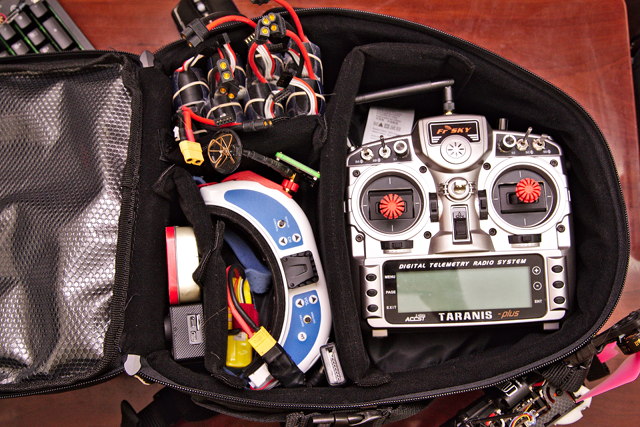
The DSLR backpack has a second compartment that’s large enough to hold a small laptop. It fits my 12” Chuwi 2-in-1 tablet just fine. You won’t fit a 15” laptop in there, though. I’d probably skip the laptop and stuff that compartment full of spare props!
Watch out! There is a larger AmazonBasics DSLR and Laptop backpack. It may be bigger, but it doesn’t have the bungie cord strap woven through the back, and that is one of the best features of the smaller bag.
- AmazonBasics DSLR Backpack at Amazon
Is a $200 backpack worth the money?
All my hopes were confirmed the first time I took my new ThinkTank bag out to the field. It used to take me three or four minutes just to get set up. I had to unstrap quads from my bag, pull out my battery bag, and then pull out and unzip my Turnigy case.
I’ve never managed to be up and flying as fast as I am with the ThinkTank bag. I just put down the bag, open the main compartment, and I pull things out as I need them. I don’t have to waste time attaching antennas to my goggles. I don’t have to unpack my transmitter from a diaper. I just pick up what I need and start flying.

Packing up is much faster, too. I’m starting to get into the habit of putting things back in their place when I finish using them. The transmitter and goggles don’t land perfectly in their compartments between flights, but they’re close.
When I’m finished flying my last battery, I’m already nearly packed up. I just have to do a bit of tidying and close the zipper. In fact, I’m usually throwing my ThinkTank backpack in the car while I’m watching everyone else spend time doing exactly what I used to have to do.

If I can save five minutes on packing and unpacking each time I fly, and I manage to get out flying once a week, that will be a savings of more than four hours every year. I imagine I’d save almost as much time using the AmazonBasics DSLR backpack. Is four hours of your time worth $27 to you? Is it worth $200? Four hours per year is worth $200 to me, and I expect to fly way more often than just once per week!
The sun is currently setting at around 5:30 p.m. Sunset has been our enemy lately. Being able to fly one more battery before sunset or before it starts raining is valuable.
- ThinkTank FPV Airport Helipak at Amazon
- AmazonBasics DSLR Backpack at Amazon
The verdict
The best drone bag is the one you already have. If you’re mostly happy with what you have, then you should absolutely keep using it. For most of you reading this, your $200 is better spent on a better transmitter, an FPV goggle upgrade, or another racing quad.
Maybe you’re new to the hobby, and you don’t have a bag. You have a racing quad, a set of box goggles, and you’re using a Flysky i6 transmitter. A $200 backpack is probably not an upgrade that will give you the most enjoyment. You can’t go wrong with the $27 AmazonBasics DSLR backpack. You will eventually outgrow it, but it will take a you a long way!
When should you buy a bag like the ThinkTank FPV Airport Helipak? Have you run out of gear to upgrade? Do you already have Fat Shark goggles, a Taranis transmitter, and more racing quads than you have time to fly? Is your free time limited enough that you value five or ten minutes saved in the field and at home?
If your answer to those questions is yes, then I highly recommend the ThinkTank FPV Airport Helipak. It is one of the best upgrades I’ve ever made to my overall flying experience.
- ThinkTank FPV Airport Helipak at Amazon
- AmazonBasics DSLR Backpack at Amazon